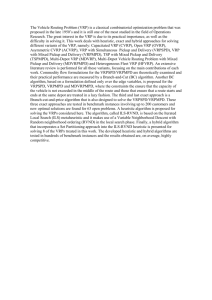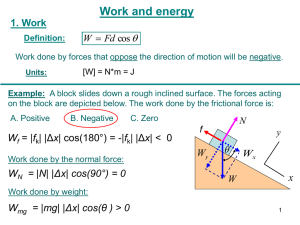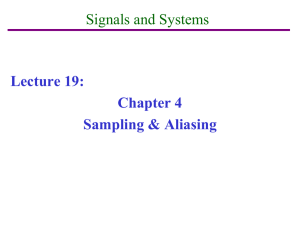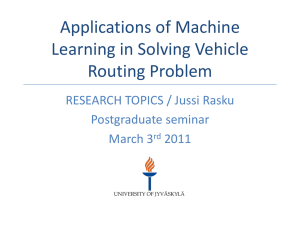sy11_oct11_f10
advertisement
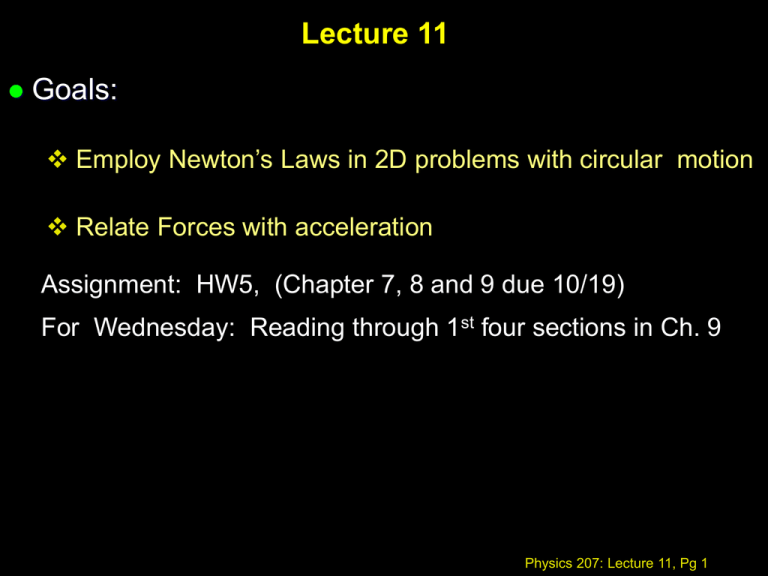
Lecture 11 Goals: Employ Newton’s Laws in 2D problems with circular motion Relate Forces with acceleration Assignment: HW5, (Chapter 7, 8 and 9 due 10/19) For Wednesday: Reading through 1st four sections in Ch. 9 Physics 207: Lecture 11, Pg 1 Chapter8 Reprisal of : Uniform Circular Motion For an object moving along a curved trajectory with constant speed a = ar (radial only) v vt2 |ar |= r ar Physics 207: Lecture 11, Pg 6 Non-uniform Circular Motion For an object moving along a curved trajectory, with non-uniform speed a = ar + aT (radial and tangential) aT vT2 |ar |= r ar |aT|= d| v | dt Physics 207: Lecture 11, Pg 7 Uniform or non-uniform circular motion implies |aradial | =vTang2 / and if there is acceleration there MUST be a net force r Physics 207: Lecture 11, Pg 8 Key steps Identify forces (i.e., a FBD) Identify axis of rotation Apply conditions (position, velocity & acceleration) Physics 207: Lecture 11, Pg 9 axis of rotation Example The pendulum Consider a person on a swing: (A) (B) (C) When is the magnitude of the tension equal to the weight of the person + swing? (A) At the top of the swing (turnaround point) (B) Somewhere in the middle (C) At the bottom of the swing (D) Never, it is always greater than the weight (E) Never, it is always less than the weight Physics 207: Lecture 11, Pg 10 Example T T y vT q mg x mg At top of swing: vT = 0 At bottom of swing: vT is max Fr = m 02 / r = 0 = T – mg cos q T = mg cos q Fr = m ac = m vT2 / r = T - mg T = mg + m vT2 / r T < mg T > mg To find the exact angle using only forces requires explicit knowledge of q and a good deal of calculus Physics 207: Lecture 11, Pg 11 Conical Pendulum (Not a simple pendulum) Swinging a ball on a string of length L around your head (r = L sin q) axis of rotation S Fr = mar = T sin q L S Fz = 0 = T cos q – mg so T = mg / cos q (> mg) r mar = (mg / cos q ) (sin q ) ar = g tan q = vT2/r vT = (gr tan q)½ Period: t = 2p r / vT =2p (r cot q /g)½ = 2p (L cos q /g)½ Physics 207: Lecture 11, Pg 12 Conical Pendulum (very different) Swinging a ball on a string of length L around your head axis of rotation Period: t = 2p r / vT =2p (r cot q /g)½ = 2p (L cos q / g )½ = 2p (5 cos 5 / 9.8 )½ = 4.38 s = 2p (5 cos 10 / 9.8 )½ = 4.36 s = 2p (5 cos 15 / 9.8 )½ = 4.32 s L r Physics 207: Lecture 11, Pg 13 Another example of circular motion Loop-the-loop 1 A match box car is going to do a loop-the-loop of radius r. What must be its minimum speed vt at the top so that it can manage the loop successfully ? Physics 207: Lecture 11, Pg 14 Orbiting satellites vT = (gr)½ Net Force: ma = mg = mvT2 / r gr = vT2 vT = (gr)½ The only difference is that g is less because you are further from the Earth’s center! Physics 207: Lecture 11, Pg 15 Geostationary orbit Physics 207: Lecture 11, Pg 16 Geostationary orbit The radius of the Earth is ~6000 km but at 36000 km you are ~42000 km from the center of the earth. Fgravity is proportional to r -2 and so little g is now ~10 m/s2 / 50 vT = (0.20 * 42000000)½ m/s = 3000 m/s At 3000 m/s, period T = 2p r / vT = 2p 42000000 / 3000 sec = = 90000 sec = 90000 s/ 3600 s/hr = 24 hrs Orbit affected by the moon and also the Earth’s mass is inhomogeneous (not perfectly geostationary) Great for communication satellites (1st pointed out by Arthur C. Clarke) Physics 207: Lecture 11, Pg 17 Loop-the-loop 1 To navigate the top of the circle its tangential velocity vT must be such that its centripetal acceleration at least equals the force due to gravity. At this point N, the normal force, goes to zero (just touching). Fr = mar = mg = mvT2/r vT vT = (gr)1/2 mg Physics 207: Lecture 11, Pg 18 Loop-the-loop 2 The match box car is going to do a loop-the-loop. If the speed at the bottom is vB, what is the normal force, N, at that point? Hint: The car is constrained to the track. Fr = mar = mvB2/r = N - mg N = mvB2/r + mg N v mg Physics 207: Lecture 11, Pg 19 Loop-the-loop 3 Once again the car is going to execute a loop-the-loop. What must be its minimum speed at the bottom so that it can make the loop successfully? This is a difficult problem to solve using just forces. We will skip it now and revisit it using energy considerations later on… Physics 207: Lecture 11, Pg 20 Recap Assignment: HW5, For Wednesday: Finish reading through 1st four sections in Chapter 9 Physics 207: Lecture 11, Pg 23




